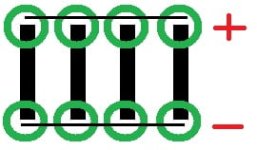Hey guys,
Been researching 18650 cell level fuses and theres something I don't get or more like missing I guess.
https://www.google.co.il/search?q=1...#imgdii=kXMERf-WlEX_5M:&imgrc=fxEFTXlvWvxYzM:
I see a busbar with two rows of cells on the sides of it and each set of two cells is soldered with a fine wire to the busbar.
First of all, where are the serial connections? I don't get whats going on here...
Are the fuses just for the parallel connections? because there is no way to transfer high current through those hairs.
and what happens if one cell goes bad? what is the benefit? what scenario can cause the higher current to be pulled from the cell so the fuse will burn?
I don't see how a case of a cell dying would burn the fuse and avoid pulling all of the parallel cells down...
Been researching 18650 cell level fuses and theres something I don't get or more like missing I guess.
https://www.google.co.il/search?q=1...#imgdii=kXMERf-WlEX_5M:&imgrc=fxEFTXlvWvxYzM:
I see a busbar with two rows of cells on the sides of it and each set of two cells is soldered with a fine wire to the busbar.
First of all, where are the serial connections? I don't get whats going on here...
Are the fuses just for the parallel connections? because there is no way to transfer high current through those hairs.
and what happens if one cell goes bad? what is the benefit? what scenario can cause the higher current to be pulled from the cell so the fuse will burn?
I don't see how a case of a cell dying would burn the fuse and avoid pulling all of the parallel cells down...


